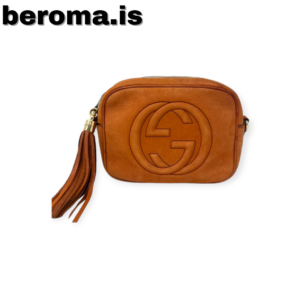Gucci, a name synonymous with luxury fashion, immaculate design, and the very essence of high-end style, has made a lasting imprint in the world of glamour. But with luxury often comes replication, and the market is awash with copies, from the street corners of bustling cities to the hidden depths of online shopping. This article ventures into the complex and fascinating world of Gucci replica bags, unpacking not just the allure of the iconic brand, but the ethical, legal, and quality factors that come into play for those who choose to purchase these intriguing fashion doppelgängers.
The Temptation of Gucci: A Designer Dream
Before we even touch on the allure of replica bags, it’s important to spotlight the brand itself. Gucci embodies the ultimate luxury experience, from its heritage woven within Italian craftsmanship to the celebrated elegance that each piece exudes. For many, owning a genuine Gucci bag is a statement of status, a uniform of the fashionable, and an investment in timeless chic.
However, this dream is often punctuated by a harsh reality—luxury comes with a hefty price tag. The exclusivity and craftsmanship that define the brand’s allure do so at a cost that isn’t accessible to everyone, causing a paradox of intense desirability combined with limited accessibility.
The Market of Replicas: A Multimillion-Dollar Shadow
Enter the world of Gucci replicas, where artisans in clandestine workshops and factories overseas set out to recreate the mystique of the Italian fashion giant. The market is an interesting microcosm that caters to the dreams of owning a designer piece without the financial sting. This segment of the fashion industry is a shadowy parallel to mainline luxury, one that thrives on availability and price, albeit at the expense of authenticity.
For the pragmatic or the unintentionally duped, replicas provide a compelling option that skirts the ethical and legal constraints of the designer industry, offering a secretive gateway into the otherwise impenetrable world of high fashion that Gucci exemplifies.
The Ethical Quandaries of Replicas
The discussion on Gucci replicas inevitably turns to an ethical crossroads. The fashion industry, already under scrutiny for its environmental impact and ethical business practices, now grapples with a segment that’s inherently duplicitous.
The purchase of a replica bag can have far-reaching consequences, despite being perceived as a victimless act. At its core, it’s a breach of the original designer’s intellectual property rights, and a contributing factor to various illicit and unregulated labor and production practices.
Yet, for some, the purchasing decision is less black and white. Economic barriers often exclude vast swaths of society from participating in trends they might otherwise aspire to. Hence, the lines between a necessary public service and detrimental dishonesty blur, posing a question on the role of replicas in democratizing fashion.
The Law and You: Navigating the Legalities of Replicas
Navigating the legal maze of Gucci replicas requires understanding a complex web of international and domestic laws on trademark infringement, copyrights, and intellectual property rights.
Counterfeit products are not only in violation of the brands they replicate but often contravene a host of domestic laws and international trade agreements. Consumers themselves can fall afoul of the law, either knowingly or unwittingly, when purchasing or even possessing replica goods, an offense that carries varying repercussions globally.
For online retailers, the sale of replicas is a particularly risky business. Sites and sellers may be shut down, fined, or even face criminal charges for trafficking in counterfeit goods. The law, it seems, is just as much a brand protector as luxury fashion houses themselves.
Mastering the Eye: Spotting a Quality Replica Gucci Bag
The art of replicating a Gucci bag involves far more than just slapping on a logo. For a replica to be convincing, it should replicate the materials, craftsmanship, and design details that define the brand’s quality. For those who dwell in the replica market, distinguishing between a poorly-made knockoff and a high-quality replica is an essential skill.
Here’s how to spot a top-tier replica:
The Material World
Authentic Gucci bags often use high-end leathers, exotics, and innovative materials like the brand’s signature canvas. Replicas should aim to mirror these as closely as possible, not just in appearance but also in the feel and scent of the leather. Pay attention to any discrepancies in texture or color that might betray a less scrupulous production.
Craftsmanship and Consistency
Gucci’s reputation for craftsmanship is built on the meticulous construction of its products. A careful examination of stitching, hardware, and overall structure can reveal whether a replica lives up to this standard. A true-to-form replica should showcase exceptional attention to detail, with no loose threads or uneven stitching.
Logo Legends
The iconic “double-G” logo is one of the most replicated insignias in the world. The accuracy of the logo application on a replica can often give the game away. Logos on authentic Gucci bags are consistent and precisely positioned, while replicas might have ill-defined or unevenly applied logos that fail to meet the brand’s attention to detail.
The Price of Identity: Comparing Genuine and Gucci Replica Bag Costs
The allure of replica bags often lies in their accessibility, but at what cost—both financial and cultural?
For many, the financial savings associated with purchasing a replica versus its authentic counterpart are the primary motivator. However, this reduced price signifies more than a discount; it’s a testament to the difference in the product’s intrinsic value. The price of an authentic Gucci bag accounts for the brand’s heritage, quality, and the cost of fair labor and sustainable materials.
The replica market undercuts this, commodifying luxury without the standards set by its original creators, leading to an inflation of the brand’s aesthetic identity at the expense of brand integrity and future sustainability.
The Influencer Effect: Gucci Replicas and Consumer Behavior
In the digital age, the role of influencers and media cannot be understated. The idolatry of luxury brands has filtered through social media, turning the coveted into the commonplace, if only virtually. Fashion influencers and industry experts are in a unique position to offer insight into this complex dynamic.
Industry insiders can provide anecdotal evidence on how the allure of Gucci and its replicas have shaped consumer behavior. From the runway to the screen, the influence of high fashion is pervasive, breeding aspirational buying habits that both fuel and are fueled by replicas.
The rise of online platforms and digital storefronts, combined with the visual impact of social media, has democratized the fashion narrative, but in doing so, has also inadvertently hastened the normalization of replicas as finishing touches for a look rather than the statement piece they’re meant to replicate.
The Future of Imitation: A Conclusion on Gucci Replicas
The future of the Gucci replica market is anything but deterministic. As the worlds of luxury fashion and digital commerce continue to collide and evolve, so too will the market for replica goods.
It’s clear that the allure of brands like Gucci is undiminished, and there will always be consumers who seek to own a piece of that prestige. However, as cultural shifts toward sustainability, authenticity, and transparency continue, the tides may turn against replicas, returning the value of luxury to its rightful place among those who can afford—and continue to support—the dream.
For consumers and retailers alike, the conversation around Gucci replicas is a call to action, a reflection on the purchase power and shared responsibility in fashion’s ongoing narrative. Only time will tell if the replica market will eternally shadow luxury or if the lights of ethical consumption and brand stewardship will outshine the temptation of imitation. The choice remains in the hands of every stakeholder in the fashion ecosystem—from the casual buyer to the trailblazing designer.
In conclusion, the Gucci replica phenomenon is not simply a matter of right or wrong; it’s a complex interplay of socio-economic factors, individual choices, and the broader market at large. As consumers, it’s important to be aware of the implications of our purchase decisions and to understand the impact they may have. For retailers, it’s a delicate dance between supply and demand, ethics, and the bottom line. And for the wider fashion world, the presence of replica bags serves as an important indicator of the industry’s present and potential future challenges and triumphs.
Whether you opt for the authenticity of a genuine Gucci bag or the allure of its replica, remember that the true value of a fashion piece is not just in its label, but in the story it tells, the people it empowers, and the legacy it leaves.
FAQ
What makes a Gucci replica bag high quality?
High-quality Gucci replicas mimic the authentic versions in material use, craftsmanship, and details such as the “double-G” logo. They pay close attention to the texture, color, stitching, and overall structure to ensure they closely match the original standards set by Gucci.
Can you easily identify a Gucci replica?
Identifying a Gucci replica requires knowledge of the brand’s authentic features, including the specific materials, craftsmanship, logo design, and placement. Inconsistencies in these areas can often reveal a bag’s replica status.
Why do people buy Gucci replicas?
People buy Gucci replicas for various reasons, including the desire to own a piece of the luxury brand at a fraction of the cost. The accessibility and visual appeal of replicas make them attractive options for those who admire the brand’s aesthetic but cannot or choose not to afford the genuine product.
What are the consequences of buying Gucci replicas?
Buying Gucci replicas can have broader implications, including supporting unethical labor practices and undermining the value of genuine luxury goods. It reflects on consumer behavior trends and raises questions about brand integrity and the sustainability of luxury fashion.
How is the influence of social media related to the popularity of Gucci replicas?
Social media has amplified the desire for luxury brands by showcasing them as status symbols, leading to increased demand for replicas among those seeking to emulate these luxury lifestyles affordably. Influencers and digital platforms play a significant role in shaping consumer perceptions and aspirational buying habits.
